TO MY READERS: HOW TO USE THE BLOG
Click Here
Its been a long time coming but the Porvenir massacre THC marker is on its way to the foundry to be cast!
TO: INTERESTED PARTIES
FROM: MARK WOLFE
DATE: SEPTEMBER 14, 2018
RE: PORVENIR MASSACRE HISTORICAL MARKER
The Texas Historical Commission (THC) has completed work on the text for its marker telling the story of the Porvenir Massacre. THC thanks all of the many individuals and organizations who have expressed an interest in, and participated in the development of, this project. We are particularly grateful for the guidance provided to staff by Commissioner Lilia Marisa Garcia, Professor of History at the University of Texas Rio Grande Valley, appointed by Governor Greg Abbott to the Texas Historical Commission earlier this year as the Commission’s official Professional Historian. With her contributions, and thorough research on the part of THC’s professional marker staff, we are confident that the text is accurate and ready to be sent to the foundry for casting early next week. On completion, in approximately six weeks, we hope that the various parties of interest will join in dedicating the marker at its permanent location in Presidio County.
Thank you again for your patience. The stories of Texas can be complex. There is much to celebrate, but there is also a darker side to our history, and those stories must also be told. The THC is the only state agency in the country to initiate a process for seeking out these “Undertold” stories and memorializing them at no cost to the state’s taxpayers. Since the Undertold Stories program was put into place in 2006, more than 110 markers have been installed, with such themes as Freedom Colonies, education, underrepresented groups, and civil rights. Only by telling these disregarded, or even forgotten, stories can we truly understand the complicated tapestry that is Texas.
We don’t take this responsibility lightly. THC markers are made to last many generations, so we take as long as necessary to finalize text. We apologize for any inconvenience that may have caused, but are confident that the end result is a better, more accurate, product.
We continue to welcome comments on this text, or on the text of any of our more than 16,000 markers across this great state. The order will go to the foundry on Tuesday morning, September 18th. Comments should be directed to Charles Sadnick (charles.sadnick@thc.texas.gov).
Thank you again for your interest and participation, and we look forward to working with you on future projects.
Texas Historical Commission staff (BB), 7/17/2015, rev 3/5/2018, 5/17/18, 9/10/18, 9/12/18, 9/13/18:
27” x 42” Official Texas Historical Marker with post
Presidio County (Job #15PS02) Subject (Atlas ) UTM:
Location: US 90, northwest of Marfa
PORVENIR MASSACRE
PORVENIR WAS A COMMUNITY IN REMOTE NORTHWEST PRESIDIO COUNTY ON THE RIO GRANDE. IN THE MIDST OF MILITARY CONFLICTS, INCREASED ETHNIC TENSIONS AND RETALIATORY RAIDS ALONG THE INTERNATIONAL BORDER AND IN THE IMMEDIATE AREA DURING THE MEXICAN REVOLUTION, THE SMALL FARMING AND RANCHING SETTLEMENT WAS THE SITE OF A NOTORIOUS TRAGEDY IN 1918.
A GROUP OF TEXAS RANGERS FROM COMPANY B IN MARFA, U.S. ARMY SOLDIERS FROM TROOP G OF THE 8TH CAVALRY, AND LOCAL RANCHERS ARRIVED AT PORVENIR IN THE EARLY MORNING HOURS OF JANUARY 28, 1918. THEY CAME TO THE RANCH OF MANUEL MORALEZ AND SEPARATED FIFTEEN ABLE-BODIED MEN AND BOYS FROM THE WOMEN, CHILDREN AND ELDERLY MEN. THOUGH INITIAL ACCOUNTS DENIED ANY WRONGDOING, LATER TESTIMONY CONFIRMED THAT THESE 15 VICTIMS WERE SHOT AND KILLED. FAMILY MEMBERS CROSSED THE RIO GRANDE INTO MEXICO TO BURY ANTONIO CASTAÑEDA, LONGINO FLORES, PEDRO HERRERA, VIVIANO HERRERA, SEVERIANO HERRERA, MANUEL MORALEZ, EUTEMIO GONZÁLEZ, AMBROSIO HERNÁNDEZ, ALBERTO GARCÍA, TIBURCIO JÁCQUEZ, RÓMAN NIEVES, SERAPIO JIMÉNEZ, PEDRO JIMÉNEZ, JUAN JIMÉNEZ, AND MACEDONIO HUERTAS.
IN JUNE 1918, GOVERNOR WILLIAM P. HOBBY AND ADJUTANT GENERAL JAMES A. HARLEY DISBANDED COMPANY B, DISMISSED FIVE RANGERS FOR THEIR ACTIONS AT PORVENIR, AND FORCED CAPTAIN J.M. FOX’S RESIGNATION. STATE REPRESENTATIVE J.T. CANALES FILED CHARGES WITH THE TEXAS LEGISLATURE AGAINST THE TEXAS RANGERS, FOR THE OPPRESSION AND MURDER OF HUNDREDS OF HISPANICS ALONG THE RIO GRANDE. AT AN INVESTIGATION BEGINNING JANUARY 31, 1919, LEGISLATORS HEARD AND RECEIVED TESTIMONY REGARDING SEVERAL INCIDENTS INCLUDING PORVENIR. AS A RESULT, THE TEXAS RANGERS WERE REORGANIZED AND REDUCED IN SIZE. IN THE AFTERMATH OF THE ATTACK, APPROXIMATELY 140 REMAINING RESIDENTS OF PORVENIR ABANDONED THE COMMUNITY.
(2015)
MARKER IS PROPERTY OF THE STATE OF TEXAS
[ view entry ] ( 3261 views ) | permalink |
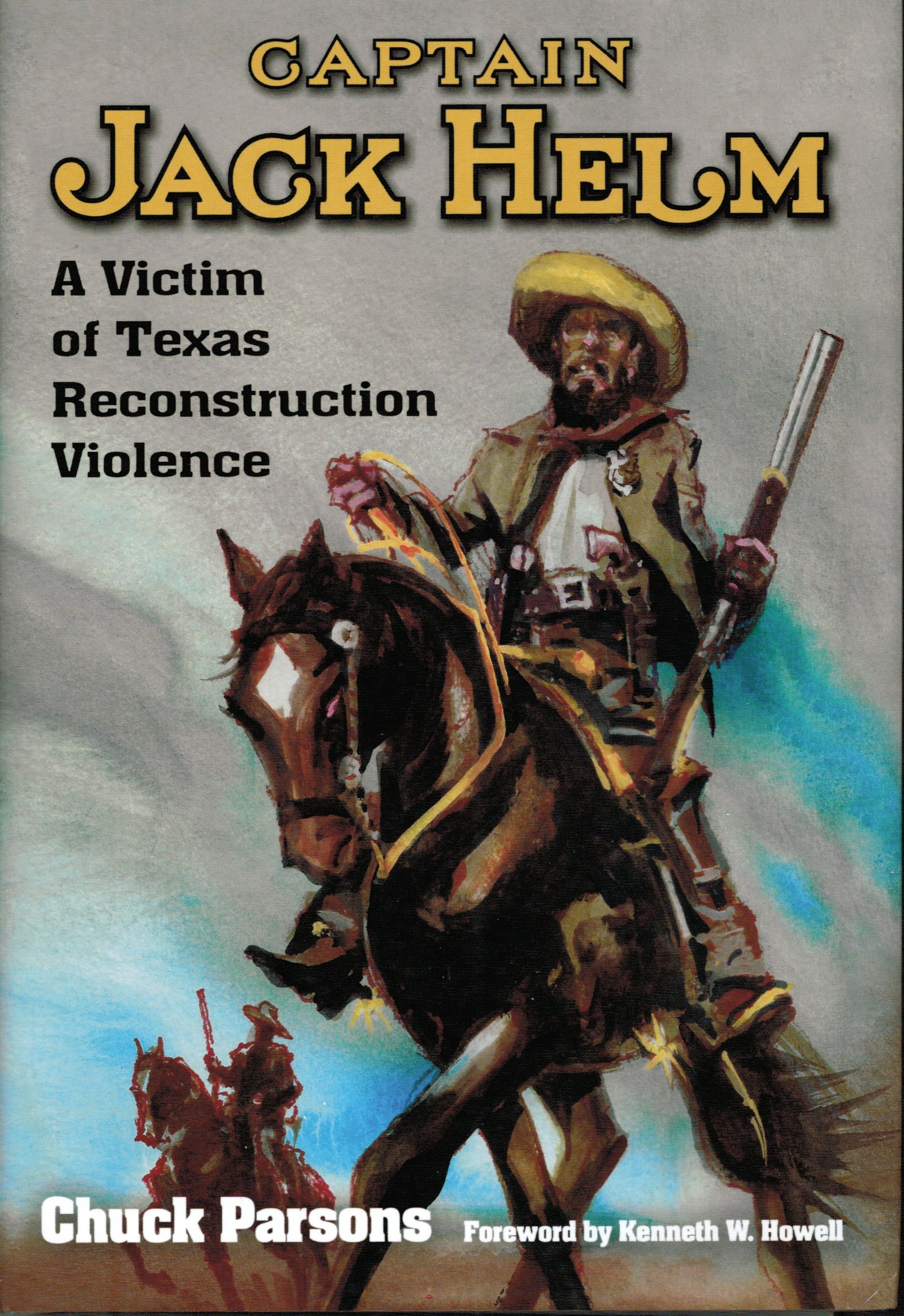
The University of North Texas Press recently published "Captain Jack Helm: A Victim of Texas Reconstruction Violence" by Chuck Parsons. Parsons has authored a number of good Texas histories/biographies including, "Captain John R. Hughes: Lone Star Ranger", "Texas Reconstruction, and Violence in the Wild West" and "The Sutton County Feud" as well as others. Parson's "Captain Jack Helm" has long been awaited and is a good read.
John Jackson (Jack) Helms or Helm according to what source is used was born in Missouri about 1836 and came to Texas with his mother and father in 1842 to settle in Lamar County. During the Civil War Jack served the Confederacy in Company G, Ninth Texas Cavalry beginning his reputation as a cold-blooded killer who showed no mercy to his victims. In 1862 Helm took part with a group of vigilantes who tried and hung five men for having Union sympathies. Following the war Jack Helm became a captain in the Texas State Police and during this time he unmistakably established himself as a violent hunter of men. The Galveston News reported that in a two-month period in the summer of 1869 Helms and his "regulators" killed twenty-one men only jailing ten fugitives. Not many criminals escaped Helm most were shot dead while "trying to escape". Parsons does a first-rate job of illustrating just how violent and chaotic reconstruction Texas really was during the years following the Civil War. Finally in 1870 Texas Governor Edmond J. Davis dismissed Helm from the state police force after he and some of his men killed Henry and Will Kelly in view of the deceased men's wives and families. The old saying of he who lives by the gun dies by the gun proved to be true in the case of Captain Jack Helm. In 1873 none other than John Wesley Hardin and Jim Taylor gunned him down.
Gj
[ view entry ] ( 3193 views ) | permalink |
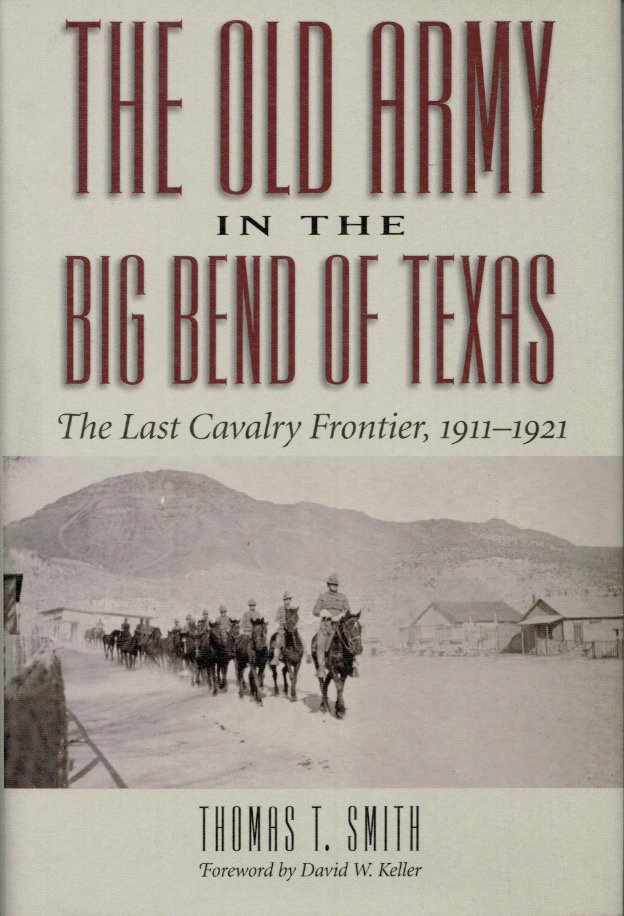
The Texas State Historical Association recently published a new title: The Old Army in the Big Bend of Texas: The Last Cavalry Frontier, 1911-1921 by Thomas T. Smith. (Austin: Texas State Historical Association, 2018. Pp.240. Illustrations, bibliography, index).
This well researched history deals with the military occupation of the far West Texas southern border by the U.S. military during the Mexican revolution. The book is an extremely interesting read and makes considerable use of official U.S. Army records. For most of the twentieth century a number of these official army records had remained classified and their scattered locations in various National Archive locations made them difficult to locate and make use of. Another problem is that a disastrous 1972 fire at the National Archives National Personnel Records Center in St. Louis, Mo. destroyed some 16-18 million documents including most of those relating to the Big Bend Military District. Smith also states correctly how unreliable newspaper accounts from these years have proved to be. The Big Bend border became off limits to newspaper reporters who were forced to depend on Army press conferences to report the news during this time period. In spite of these obstacles author Thomas Smith does a commendable job of researching this difficult topic.
The U.S. Army largely had been absent from the Big Bend from the 1890’s until the outbreak of the Mexican Revolution in 1910. During a decade of civil war in Mexico, the resulting border raids, theft of livestock as well as an immense and constant stream of refugees fleeing the war into the United States greatly compounded these problems. U.S. military presence expanded on the border at a steady rate until Pancho Villa’s bold attack on Columbus, New Mexico in March 1916 in which seven American soldiers and eight civilians lost their lives in the first invasion of the United States by a foreign army since the war of 1812. This prompted President Woodrow Wilson to order General John J. Pershing and some 10,000 U.S. troops into Chihuahua in an attempt to capture or kill the elusive Villa. Then on night of May 5 1916 a band thought to be Villista raiders attacked Glenn Springs, in the Texas Big Bend, killing three U.S. soldiers and a nineteen-year-old boy. About the same time, a second group of marauders robbed Jesse Deemer’s store at Boquillas a few miles downriver from Glenn Springs. The bandits kidnapped Deemer and his storekeeper and crossed the Rio Grande where they robbed the American owned Boquillas mine and took two more captives. On May 7 a U.S. Army punitive expedition headed by Col. Frederick W. Silbey and Maj. George T. Langhorne set out from Marathon with about 80 cavalry troopers. The expedition remained in Chihuahua for seven days and managed to free the two hostages and kill five of the raiders. On June 18, 1916 President Woodrow Wilson mobilized the National Guard sending some 156,000 guardsmen to the U.S. Mexican border.
Thomas Smith does an outstanding job of documenting these critical events that led to a huge military build up of this remote border region. Using Regimental Returns and other primary source military records the author details the locations of the U.S. Army border outposts, their years of operation, the commanders of these units and their tactics as well as providing valuable time lines that will be a great aid to future researchers, writers as well as history buffs. In view of today's not dissimilar border troubles, Smith’s fine military history provides his readers with valuable insight from a historical perspective.
Glenn Justice
[ view entry ] ( 2239 views ) | permalink |

University of North Press has announced the publication of "T-Bone Whacks and Caviar Snacks" by travel and food authors Sharon and Tom Hudgins. This is the first cookbook in America to focus on the foods of the Asian side of Russia. Filled with fascinating food history, cultural insights and personal stories, it chronicles the culinary adventures of two intrepid Texas who lived, worked, and ate their way around Siberia and the Russian Far East.
Featuring 140 traditional and modern recipes, with many illustrations, ""T-Bone Whacks and Caviar Snacks" includes dozens of regional recipes from cooks in Asian Russia, along with recipes for the European and Tex-Mex dishes that the author and her husband cooked on the "Stoves-from-Hell" in their three Russian apartments, for intimate candlelight diners during the dark Siberian winter and for lavish parties throughout though out the year.
You'll learn how to make fresh seafood dishes from Russia's Trans-Siberian luxury train and flaming "Baked Siberia", the Russian twist on "Baked Alaskan". And here's the bonus: all of these recipes can be made with ingredients from you local supermarket or your nearest delicatessen.
[ view entry ] ( 2116 views ) | permalink |
Check out the latest El Paso Times about the Porvenir massacre and our upcoming commeration. See:
http://www.elpasotimes.com/story/news/2 ... 058345001/
Gj
[ view entry ] ( 2369 views ) | permalink |
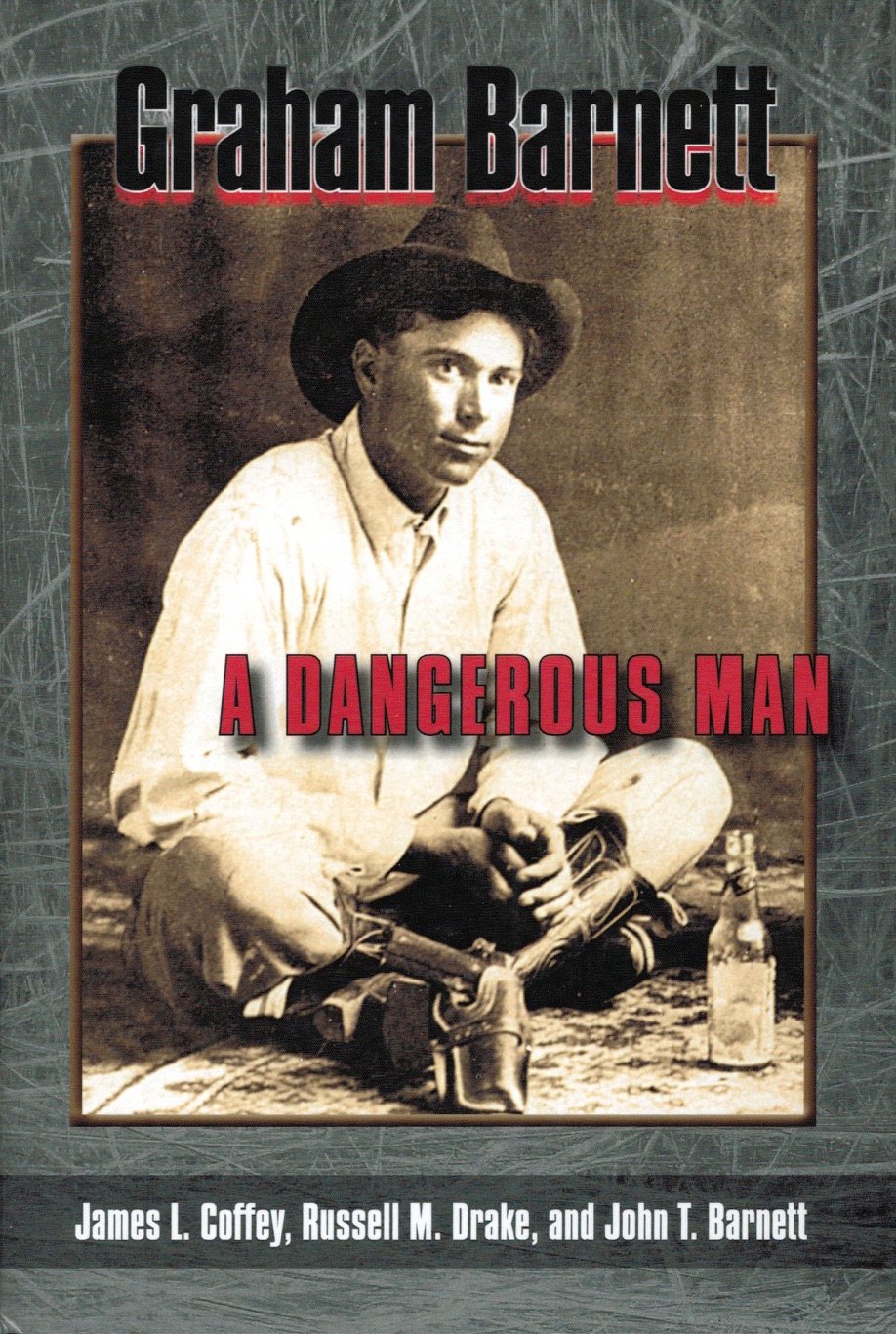
The University of North Texas Press has published a new book titled, "Graham Barnett: A Dangerous Man" written by James L. Coffey, Russell M. Drake and John T. Barnett. This book is the absorbing story of an early twentieth-century west Texas lawman who earned a fearsome reputation as a gunman with a badge by killing a number of men in drunken rages. Barnett was tried and acquitted twice for murder before he met a bad end when Upton County Sheriff Bill Fowler shot him full of holes with a Thompson machine gun at Rankin, Texas in 1931. Born in 1890 Graham began his lawman career when he signed on as a Texas Ranger in the spring of 1916.
He served under Ranger Company B’s infamous Captain J. Monroe Fox now forever remembered as the Texas Ranger Captain who ordered the horrific Porvenir massacre in January 1918 during which a group of Company B rangers assisted by Eighth Cavalry troopers of Troop B shot and killed fifteen innocent Hispanic farmers in far northwest Presidio County. The “dangerous man” writers including Graham’s own grandson, John Barnett, speculate that Graham did not take part in the massacre. Inexplicably, however, they disclose to their readers that Graham’s own brother, Boog, also a Texas Ranger in Company B during those years, claimed that “he and Graham were both present” at the massacre. No reference is cited in this curious admission however the writers incorrectly state that the massacre happened in December 1917. The Porvenir massacre did not occur in December 1917 but actually went down in the early morning hours of January 28, 1918. Having researched the massacre for many years I have to agree with the “Dangerous Man” creators that previously I have not found Graham or Boog Barnett’s names associated with the massacre but because of this odd admission I must add it to my list of possibilities and keep looking. With reference to the authors claim “That sounds like something ole’ Graham Barnett would do”, I whole heartily agree.
Overall, “Graham Barnett: A Dangerous Man” is a very good historical study in addition to being a most interesting and readable work. It finely details the life of one of the more prominent Texas Ranger gunman who emerged in the early twentieth century. Also, this book is an interesting look at how west Texas law enforcement changed and evolved as the Texas oil industry first brought prosperity to the state and its people. I highly recommend this book to anyone interested in Texas history.
Glenn Justice
[ view entry ] ( 2526 views ) | permalink |
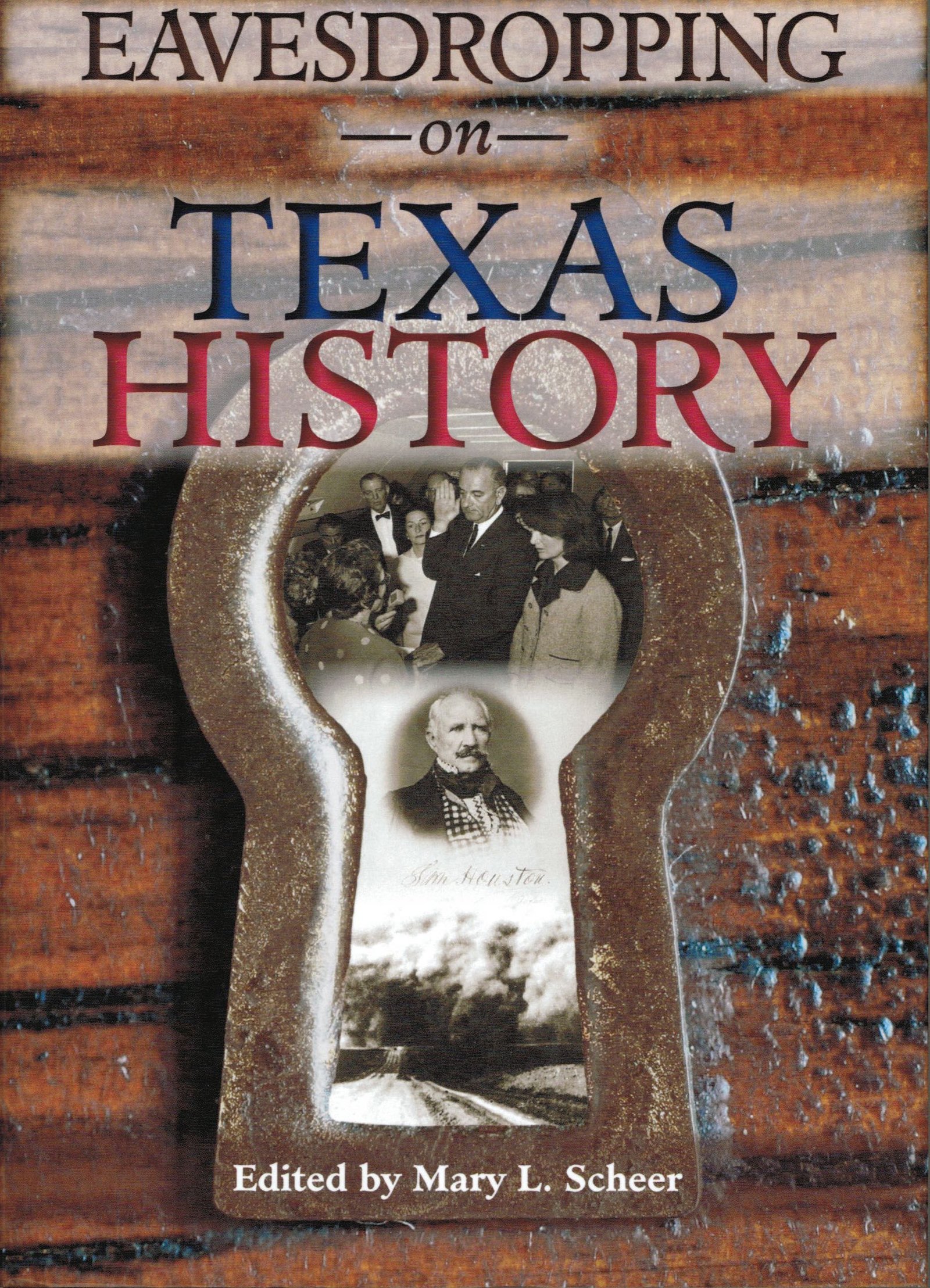
The University of North Texas Press recently published a thought-provoking new book titled “Eavesdropping on Texas History”, ISBN #9781574416879, 342 pages. Editor Mary L. Sheer posed an intriguing question to fifteen recognized Texas historians by asking, “At what point in Texas history would you have liked to have been a ‘fly on the wall’ and why?’ ” Each of these scholars responded by submitting their answers in the form of an essay that when combined make up the book. “Eavesdropping on Texas History“ offers a varied collection of historical topics each written by an expert on the subject. The articles are diverse and well documented using both primary and secondary sources covering Texas events taking place between 1811 and 1967. Some of the more notable subject matter includes, Stephen F. Austin, the fall of the Alamo, Sam Houston,Cynthia Ann Parker, the Dust Bowl and Lyndon Baines Johnson. The well-documented notes of each of the authors demonstrate the research difficulties encountered by most historians in dealing with conflicting and flawed accounts, as well as lost, missing and poorly written documents.
The fifteen writers are made up of two State Historians of Texas, two former presidents of the Texas State Historical Association, four current or past presidents of the East Texas Historical Association, two former presidents of the West Texas Historical Association as well as two Fulbrite scholars and seven award winning authors. Mary L. Sheer is professor of History and department chairman at Lamar University and a Fulbrite Scholar to Germany. She wrote “Women and the Texas Revolution” and others. “Eavesdropping on Texas History” is a fine and interesting read that should be enjoyed by a wide number of readers who love Texas history.
Glenn Justice
[ view entry ] ( 2819 views ) | permalink |
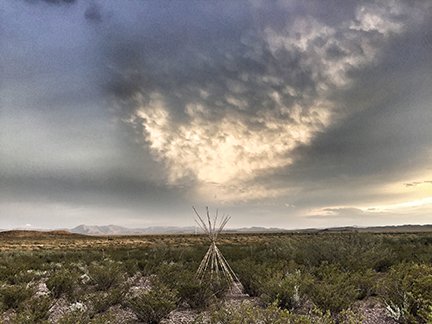
PHOTO BY JESSICA LUTZ
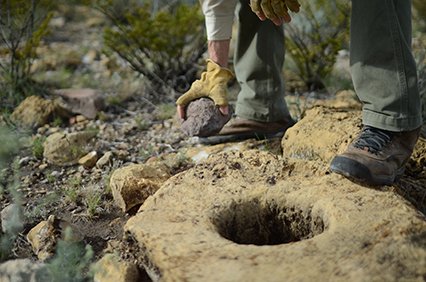
PHOTO BY JESSICA LUTZ
While many know about the Trans-Pecos Pipeline project in the Big Bend few realize that it is poised to destroy untold numbers of archeological sites in its path. Just as Energy Transfer Partners have shown their disregard for sacred sites in North Dakota, so they continue to ignore pleas to protect sites in far West Texas. One that has brought this issue to a head is the Trap Spring site on the eastern front of the Davis Mountains -- a site so significant that it qualifies for the highest honors bestowed upon archeological sites in the state.
Despite this and the fact that the pipeline company's own archeologist recommended avoidance, the company has failed to re-route the pipeline away from the site. As a result, Trap Spring may lose precious features and artifacts in addition to stripping its eligibility as a State Archeological Landmark for which it has been nominated.
This is happening just as a media storm has erupted regarding the Sioux Indians fighting yet another ETP pipeline in North Dakota. Because we have few First Nations remaining in Texas, the only people remaining here to protect this site are the ranchers, conservationists, and archeologists who fully appreciate its value.
For more information see John MacCormack's San Antonio-Express News article at: http://www.expressnews.com/news/local/a ... il-premium
[ view entry ] ( 3174 views ) | permalink |
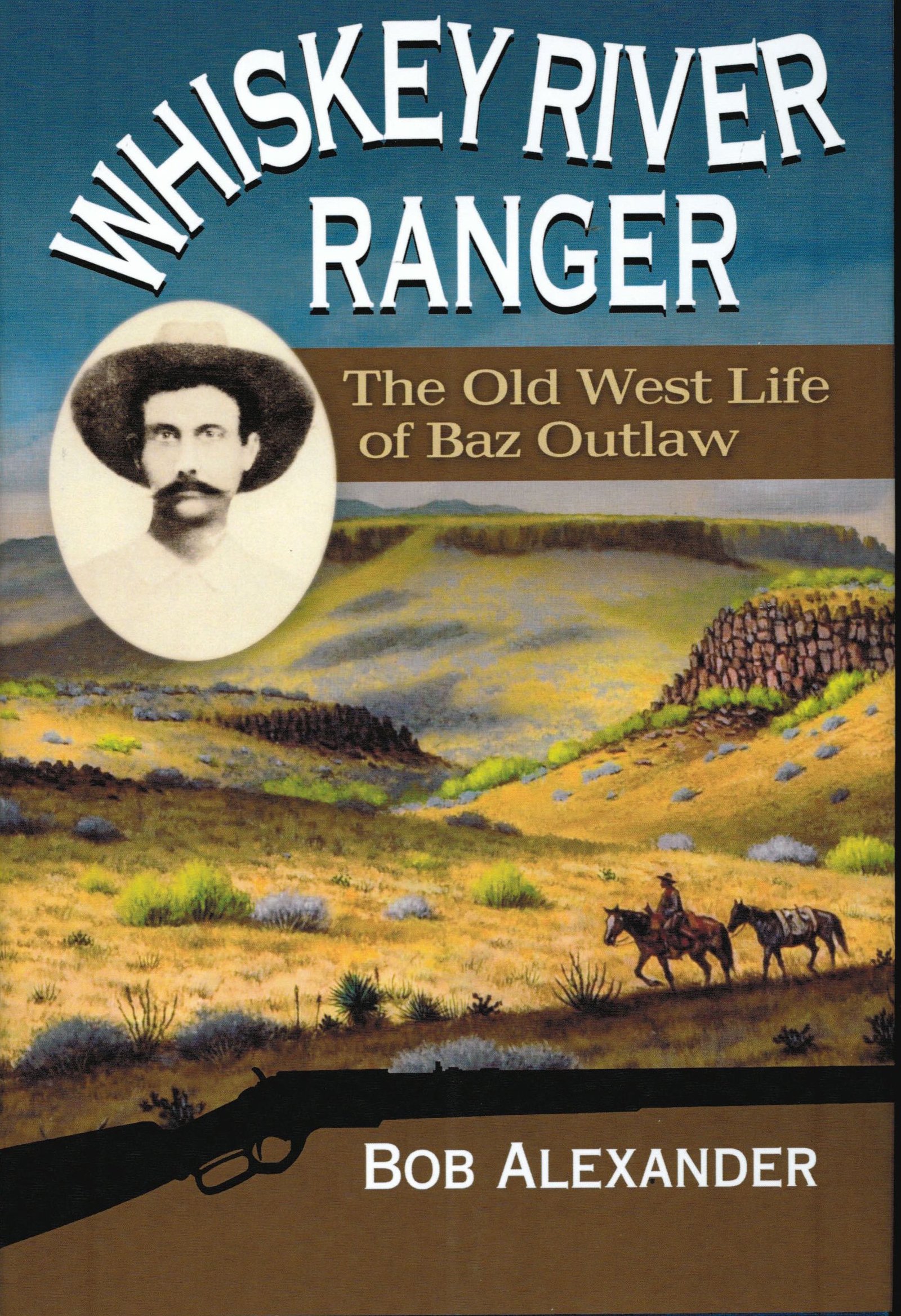
Captain Frank Jones, a famed Texas Ranger, said of his company’s top sergeant, Baz Outlaw (1854-1894), “A man of unusual courage and coolness and in a close place is worth two or three ordinary men.” Another old time Texas Ranger declared that Baz Outlaw “was one of the worst and most dangerous” because “he never knew what fear was.” But not all thought so highly of him. In "Whiskey River Ranger", Bob Alexander tells for the first time the full story of this troubled Texas Ranger and his losing battle with alcoholism.
In his career Baz Outlaw wore a badge as a Texas Ranger and also as a Deputy U.S. Marshal. He could be a fearless and crackerjack lawman, as well as an unmanageable manic. Although Baz Outlaw’s badge wearing career was sometimes heroically creditable, and at other times his self-induced nightmarish imbroglios teased and tested Texas Ranger management’s resoluteness.
Baz Outlaw’s true-life story is jam-packed with fellows owning well-known names, including Texas Rangers, city marshals, sheriffs, and steely-eyed miscreants. Baz Outlaw’s tale is complete with horseback chases, explosive train robberies, vigilante justice (or injustice), nighttime ambushes and bushwhacking as well as episodes of scorching six-shooter finality. Baz met his end in a brothel brawl at the hands of John Selman, the same gunfighter who killed John Wesley Hardin”.
Author Bob Alexander is a retired lawman himself. He began his policing career in 1965 and retired as a special agent with the U.S. Treasury Department. He is author of “Rawhide Ranger, Ira Aten” (winner of WWHA Best Book Award); “Six-Shooters and Shifting Sands”, “Bad Company and Burnt Powder”, “Riding Lucifer’s Line”, and “Winchester Warriors” all published by UNT Press. He lives in Maypearl, Texas.
[ view entry ] ( 3127 views ) | permalink |
John MacCormack wrote an excellent article on our archaeological work at Porvenir for the San Antonio Express. The Associated Press picked up the story and it ran in nearly a dozen newspapers nationwide! To read it click on the below link:
http://newsok.com/article/feed/993031
Also my article about the recent archaeological work just ran in second quarter Cenizo Journal.
Gj
[ view entry ] ( 3124 views ) | permalink |
<Back | 1 | 2 | 3 | 4 | 5 | 6 | 7 | 8 | 9 | 10 | Next> Last>>